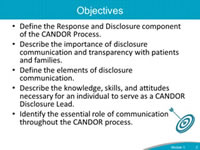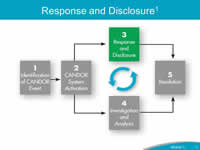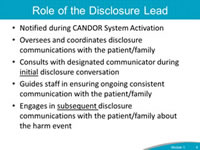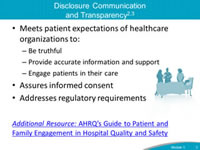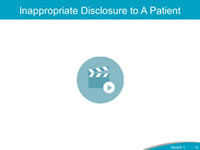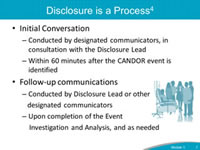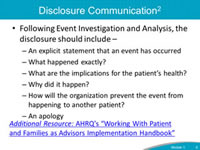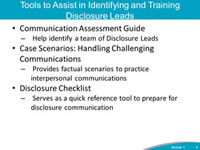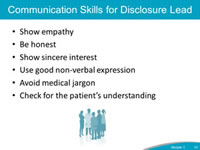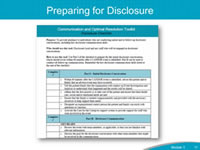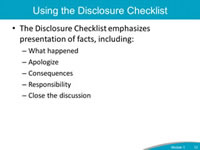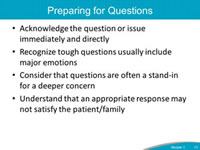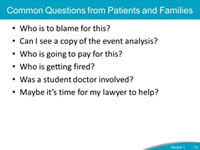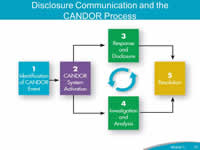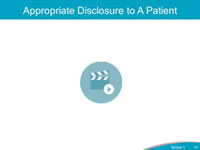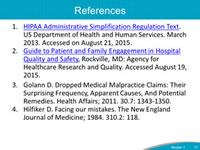Module 5: Response and Disclosure
AHRQ Communication and Optimal Resolution Toolkit
Facilitator Notes
|
Say: In Module 5 of the CANDOR Toolkit, we will discuss the Response and Disclosure component of the CANDOR process. |
Slide 1
|
|
Say: The goal of this module is to:
|
Slide 2
|
|
Say: The third component of the CANDOR process is Response and Disclosure. Disclosure is defined by HIPAA as the "release, transfer, provision of access to, or divulging in any manner of information outside the entity holding the information." In the CANDOR process, disclosure means communicating with patients, families, and caregivers concerning a CANDOR event.The Response and Disclosure component should begin within 60 minutes after a CANDOR event has been identified and include ongoing communication with the patient and/or family as more is learned about the event. This component of the CANDOR process is grounded in effective and transparent communication with caregivers, patients, and/or families following a CANDOR event. |
Slide 3
|
|
Say: Response and Disclosure is led by a team of trained Disclosure Leads. The knowledge, skills, and attitudes necessary for an individual to serve as a Disclosure Lead will be described later in the module.A Disclosure Lead is notified of the CANDOR event during CANDOR System Activation and is responsible for coordinating the overall disclosure communication with the patient and/or family. The initial disclosure conversation will be conducted by either a Disclosure Lead or a "designated communicator," in consultation with a Disclosure Lead. Following the initial disclosure conversation, only a Disclosure Lead or other designated communicator will engage in followup communication with the patient and/or family about the harm event. Additionally, the Disclosure Lead guides all caregivers in delivering consistent communication, to ensure that everyone stays "on message" when responding to the patient and/or family about the event. |
Slide 4
|
|
Say: Response and Disclosure is an important step in demonstrating effective, open, and transparent communication following an adverse event. There are several reasons this communication is so vital to the CANDOR process. First, health care organizations have a commitment to meet patient expectations for safe, quality care. Patients expect their providers and health care organizations to be truthful and to provide accurate, clear, open, and honest communication. This type of communication can improve how well patients are informed about their care and can promote patient engagement. Research has demonstrated that patient and family engagement can lead to measurable improvements in safety and quality. The Agency for Healthcare Research and Quality developed a tested, evidence-based "Guide to Patient and Family Engagement in Hospital Quality and Safety." Patients can help hospitals work as partners with patients and families to improve quality and safety.Disclosure communication can also be viewed as an extension of the informed consent process. The patient and/or family have a reasonable expectation to be informed when a harm event has occurred and of the impact of the event on their care. Transparent and timely communication with patients and/or families during their care, particularly when an adverse event occurs, is also reinforced in many State laws and hospital policies and by accrediting agencies like The Joint Commission. While not the ultimate goal, disclosure communication and transparency may lead to possible reductions in legal liability. Think about your own organization's policies regarding communication with patients and families following an adverse event. Are there standards all caregivers are expected to meet? Do hospital policies provide guidelines for communicating with patients and families? As a patient in your organization, would you feel comfortable with your organization's current disclosure communication process?
|
Slide 5
|
|
Say: As you think about the process of communicating with patients and families following an adverse event, let's watch this video showing an example of inappropriate disclosure to a patient.Ask: After watching the video, can you describe why this was an inappropriate disclosure to a patient? What could be done to improve the disclosure communication? |
Slide 6
|
|
Say: Disclosure communication is a process and not an isolated event, since there are many different points at which disclosure conversations can occur.The first disclosure communication occurs within 60 minutes after a CANDOR event has been identified, and this is the initial conversation with the patient and/or family. This conversation sets the stage for future communication. Based on the circumstances of the event, a designated on-site communicator will be identified to conduct this conversation with the patient and/or family, in consultation with a Disclosure Lead. The objective of this initial conversation is to advise the patient and/or family that an adverse event may have occurred, and that the organization will conduct an Event Investigation and Analysis to understand what happened. Once this has been completed, it should be explained that the findings will be shared with them. Until then, the first priority is to take care of the patient and ensure that their health care, social, and emotional needs are the top priority. Additionally, the family should be treated compassionately and provided with the necessary resources to help support their needs. Designated communicators participating in the initial disclosure conversation must demonstrate genuine caring and concern for the patient. It is important to explain to the patient and/or family that there will be followup conversations with them and provide assurance of availability to answer any additional questions in the future. |
Slide 7
|
|
Say: The CANDOR Process encourages organizations to minimize the time between the initial disclosure conversation and followup communications with patients and families. The first followup communication usually occurs after the completion of the Event Investigation and Analysis. In this followup conversation, the Disclosure Lead or other designated communicator presents the results of the event analysis;, discusses the prevention plans; responds to the patient's and or family's questions; and addresses, if needed, their concerns regarding compensation. During disclosure, patients and families generally want a clear, explicit statement that an event has occurred. Disclosure communication following an adverse event should include answers to the following questions:
Patients and families can be engaged as partners in organizational discussions about harm prevention policies and disclosure communication. The Agency for Healthcare Research and Quality's Guide to Patient and Family Engagement referenced in a previous slide includes a tool to help organizations work with patients and families as advisors at the organizational level to promote patient- and family-centered approaches to improving quality and safety. Finally, an element of the disclosure that is often forgotten is the apology. It is important that the clinicians and the health care organization apologize for the adverse event, expressing genuine empathy, caring, and concern for the patient and family. |
Slide 8
|
|
Say: The CANDOR process recognizes the value of effective disclosure communication and the importance of selecting and training appropriate individuals to communicate with patients, families, and staff after a patient harm event. The organization should identify a team of Disclosure Leads who can develop the knowledge, skills, and attitudes needed to communicate with patients and families after a harm event in a thoughtful, compassionate, and clear manner.Several tools in the toolkit can be used to identify Disclosure Leads and help them train and prepare for conducting disclosure communications:
On the next slide, we will discuss communication skills needed to serve as a Disclosure Lead. |
Slide 9
|
|
Say: The CANDOR Process recognizes the value of effective disclosure communication and the importance of selecting individuals with the appropriate skills and attitudes to communicate with patients, families, and staff after a patient harm event. The organization should identify a team of Disclosure Leads who can use and further develop the knowledge, skills, and attitudes needed to communicate with patients and families after a harm event in a thoughtful, compassionate, and clear manner. A number of key communication skills can ensure the Disclosure Lead is effective in communicating after an adverse event.First, show empathy. Allow the patient and/or family to express their emotions. Acknowledge and validate their emotions by saying that their response is understandable. Next, be honest in explaining the facts about the adverse event without the patient and/or family having to do a lot of probing. Give direct answers to the patient's and/or family's questions, if you have them. If you do not know the answer to their questions, state this directly and explain your plan to learn more and keep them updated. Focus on using effective communication strategies throughout the discussion. Always show sincere interest in the patient's and/or family's questions and concerns. It also helps to use good non-verbal expressions like good eye contact when communicating with patients and family members. Avoid medical jargon when communicating, and check in frequently to make sure they understand the information being presented throughout the conversation. |
Slide 10
|
|
Say: Because of its significance in the CANDOR process, communication requires targeted training and skill development, especially when communicating with patients, families, and caregivers involved in a harm event. The Disclosure Checklist is a reference tool that provides Disclosure Leads and staff with the basic principles of disclosure after an adverse event. The organization can prepare staff by using this tool to review the intent and purpose of the disclosure conversation and to remind staff of key listening and empathy skills.This checklist can be used to:
|
Slide 11
|
|
Say: The Disclosure Checklist includes:
|
Slide 12
|
|
Say: Patients and families may present difficult questions that the team or Disclosure Leads will need to address either themselves or through support for the clinician involved in the initial conversation. Some key principles for responding to questions from patients and families following a harm event include:
On the next slide, we will discuss some examples of tough questions and potential responses to these questions. |
Slide 13
|
|
Say: Let's consider some common questions that may be posed by patients and families during the initial disclosure conversation and followup communication.Ask: Ask the group how they would respond to each question before providing potential responses.
|
Slide 14
|
|
Say: As we have seen, effective communication is the foundation for the Response and Disclosure component, but it also plays an essential role in each part of the CANDOR process. Starting with the identification of a CANDOR event, timely and clear communication is needed to engage the right people to activate the CANDOR process. When activating the Care for the Caregiver program, thoughtful communication with staff ensures that they feel supported after being involved in an unanticipated patient harm event. In Resolution, compassionate communication helps patients and families feel comfortable that steps have been taken following an adverse event to prevent a similar event from happening to another patient. Effective communication among staff, patients, and families is the key to ensuring that health care organizations respond in a timely, thorough, and just manner to an unexpected patient harm event. |
Slide 15
|
|
Say: The previous slides included information about the communication skills needed to provide an effective initial disclosure and followup communication.Let's watch this video showing an example of an appropriate disclosure conversation with a patient. After watching the video, can you identify the communication skills the Disclosure Lead exhibited? How does the patient react to this type of disclosure communication, compared to the patient's reaction in the earlier video? In Module 6, we will discuss in more detail the Event Investigation and Analysis component of the CANDOR process. |
Slide 16
|
|
|
Slide 17
|





